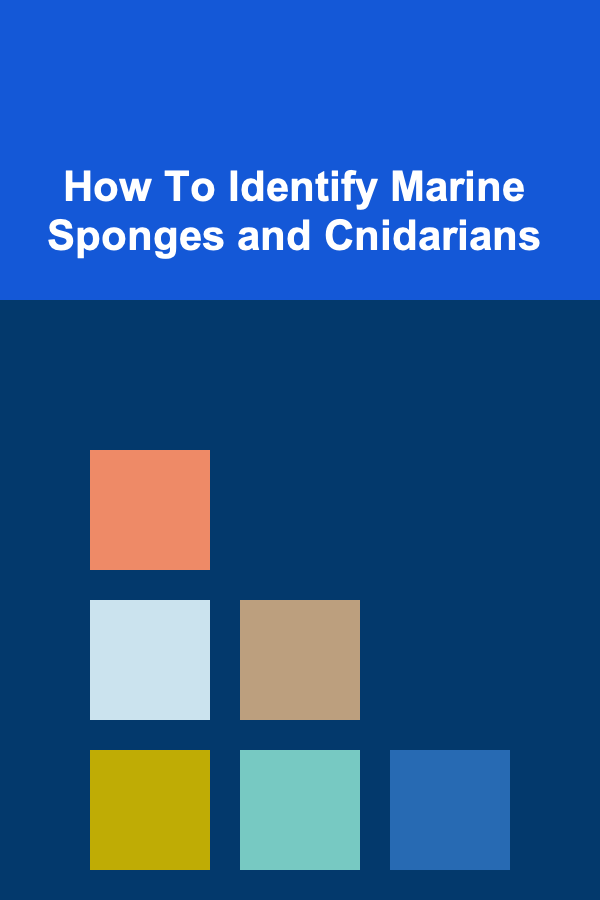
How To Identify Marine Sponges and Cnidarians
ebook include PDF & Audio bundle (Micro Guide)
$12.99$10.99
Limited Time Offer! Order within the next:

Marine life is diverse and fascinating, with organisms that exhibit extraordinary forms, colors, and behaviors. Among the vast array of marine life, two of the most intriguing groups are sponges (Phylum Porifera) and cnidarians (Phylum Cnidaria). These groups are found in marine ecosystems worldwide, playing crucial roles in the structure of coral reefs, food webs, and the health of marine environments.
Identifying these organisms is not only essential for marine biology studies but also for conservation efforts. Whether you are a scientist, diver, or marine enthusiast, being able to identify sponges and cnidarians can deepen your understanding of marine ecosystems. This article will provide a detailed guide on how to identify these fascinating creatures, examining their distinctive features, habitats, and behaviors.
Marine Sponges (Phylum Porifera)
Sponges are simple, multicellular organisms that lack tissues and organs. They are primarily aquatic, with a vast majority living in marine environments. Sponges are crucial to marine ecosystems as filter feeders, playing a significant role in nutrient cycling by filtering water and providing habitats for various marine species.
1. Physical Features of Sponges
The structure of sponges is radically different from that of most other animals. They are characterized by their porous bodies, which allow water to flow through them, filtering out microscopic food particles. Here are some key features to look for when identifying marine sponges:
a. Body Structure
Sponges have a unique body structure, typically consisting of a central cavity (the spongocoel) and numerous small pores (ostia) on the surface that lead into the cavity. The body is supported by a skeleton made of spicules (tiny, needle-like structures) or spongin (a protein fiber). The arrangement and composition of these structures can vary greatly between different sponge species.
- Spicules: These can be made of silica or calcium carbonate, and their shape and size can help in identifying the species.
- Spongin: Some sponges have a soft, flexible skeleton made of spongin, which is a fibrous protein. These sponges tend to be softer and are often referred to as "bath sponges."
b. Shape and Size
Sponges come in a wide range of shapes and sizes. Some are globular or barrel-shaped, while others may appear as branching or encrusting forms. The overall appearance is usually asymmetric. Sponges can be tiny, only a few centimeters across, or massive, reaching several meters in diameter.
c. Surface Texture
The surface texture of a sponge can be smooth, bumpy, or rough. Some species have spiny projections, while others have a velvety or soft appearance. The texture can be an important clue in species identification.
2. Color of Sponges
Sponges exhibit a remarkable variety of colors, including shades of red, orange, purple, green, yellow, and brown. The colors are often due to pigments produced by the sponge, and they can vary depending on environmental factors like depth, water clarity, and the presence of symbiotic algae or bacteria.
3. Behavior and Habitat of Sponges
Sponges are usually sessile, meaning they remain fixed in one location throughout their lives. They can be found in a variety of marine habitats, ranging from shallow coral reefs to deep-sea environments. Some sponges live on hard substrates such as rocks or coral, while others may grow on soft substrates like mud or sand.
4. Identifying Sponges by Family
There are several different families within the Phylum Porifera. While the identification of sponges at the family level can be challenging without specialized equipment, certain characteristics can guide identification:
- Demospongiae: The largest and most diverse class, demosponges have spongin or silica spicules and include species that are bath sponges.
- Hexactinellida: Known as "glass sponges," these have silica spicules that form a lattice-like structure.
- Calcarea: These sponges have calcium carbonate spicules and are typically found in shallow, tropical waters.
Marine Cnidarians (Phylum Cnidaria)
Cnidarians are a diverse group of animals that include well-known organisms such as jellyfish, corals, sea anemones, and hydroids. They are characterized by their radial symmetry, stinging cells called cnidocytes, and a simple body structure consisting of a single opening surrounded by tentacles.
1. Physical Features of Cnidarians
Cnidarians have a relatively simple body plan compared to other animals. Their body is typically divided into two main parts: the polyp and the medusa. These forms are not always present in all cnidarians, but they are common among the group.
a. Cnidocytes and Nematocysts
The most distinctive feature of cnidarians is their cnidocytes---specialized cells that contain stinging organelles called nematocysts. These cells are used for defense and prey capture. The nematocysts can inject toxins into the target, which can be harmful to prey or predators. This feature is crucial for identifying cnidarians.
b. Radial Symmetry
Cnidarians exhibit radial symmetry, meaning their body parts are arranged symmetrically around a central axis. This symmetry is a key characteristic used to distinguish cnidarians from other animals, which often exhibit bilateral symmetry.
c. Body Forms: Polyp and Medusa
Cnidarians can exist in two primary body forms:
- Polyp: A stationary, cylindrical form that is typically attached to a substrate. Polyps are common in sea anemones and coral.
- Medusa: A free-swimming, bell-shaped form, typical of jellyfish. The medusa has a prominent umbrella-like body with tentacles hanging from the edges.
2. Color and Texture of Cnidarians
Cnidarians exhibit a wide range of colors, including vibrant reds, blues, and greens, often due to symbiotic relationships with algae or pigments produced by the cnidarians themselves. Their bodies may have a gelatinous, soft texture, particularly in jellyfish and hydroids, while coral and sea anemones may have more solid and firm bodies.
3. Behavior and Habitat of Cnidarians
Cnidarians can be found in a variety of marine environments, from shallow coastal areas to deep ocean waters. Many species, such as corals and sea anemones, are sessile, while jellyfish and hydroids are more mobile. They can be found on hard surfaces like rocks or coral reefs, or floating freely in the water column.
4. Identifying Cnidarians by Class
Cnidarians are divided into four main classes:
- Hydrozoa: Includes species like the Portuguese man o' war and hydra. They can have both polyp and medusa stages, and often form colonies.
- Scyphozoa: True jellyfish, which typically have a large medusa stage and a reduced polyp stage.
- Anthozoa: Includes corals and sea anemones. These organisms are exclusively polyps and are often found in large colonies.
- Cubozoa: Box jellyfish, which have a cube-shaped bell and potent venom.
Techniques for Identifying Marine Sponges and Cnidarians
When identifying marine sponges and cnidarians in the field, you may use several techniques to help narrow down species identification:
1. Visual Observation
Careful observation of shape, color, size, and surface texture is essential for identifying sponges and cnidarians. In sponges, note the presence of spicules or spongin, and the type of skeleton. For cnidarians, look for distinctive features like the presence of tentacles, the type of symmetry, and the presence of a medusa or polyp form.
2. Microscopic Examination
For more accurate identification, especially in sponges, microscopic examination may be necessary to observe the structure of spicules or other skeletal elements. In some cases, taking small tissue samples for later analysis can provide insight into the species.
3. Genetic Analysis
DNA barcoding has become an important tool for identifying marine organisms, including sponges and cnidarians. Genetic markers can be used to confirm species identification, particularly for species that are difficult to distinguish based on morphology alone.
4. Consulting Field Guides and Databases
Using field guides, marine biology references, or online databases can be immensely helpful when identifying marine species. Many resources contain detailed descriptions and images of sponges and cnidarians, which can serve as valuable references for both beginners and experienced marine biologists.
Conclusion
Identifying marine sponges and cnidarians requires a deep understanding of their distinctive physical features, behaviors, and habitats. Both groups of organisms are integral to marine ecosystems, and being able to identify them can help researchers monitor biodiversity, understand ecological dynamics, and contribute to conservation efforts.
While the task may seem daunting at first, with careful observation, the use of various identification tools, and a solid grasp of the characteristics of these creatures, anyone can become adept at identifying marine sponges and cnidarians. The more we know about these fascinating organisms, the better equipped we are to protect and preserve our oceans for future generations.

How to Incorporate Personal Touches into Your Party Planning
Read More
How to Monetize Deep Learning Models in the E-commerce Space
Read More
How to Organize Your Home for Better Energy Flow
Read More
Start Here: The Guide to Stress Management
Read More
How To Understand Bird Migration Patterns
Read More
How To Protect Your Family's Data Privacy
Read MoreOther Products

How to Incorporate Personal Touches into Your Party Planning
Read More
How to Monetize Deep Learning Models in the E-commerce Space
Read More
How to Organize Your Home for Better Energy Flow
Read More
Start Here: The Guide to Stress Management
Read More
How To Understand Bird Migration Patterns
Read More